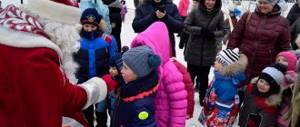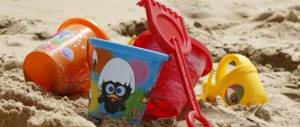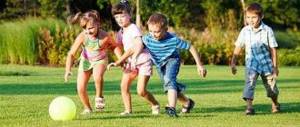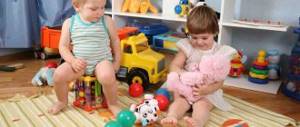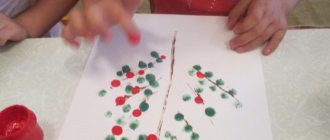The role of outdoor games in the physical education of preschool children.
The formation of children's health and the full development of their body is one of the main problems in modern society. During preschool childhood, the foundations of health, comprehensive physical fitness and harmonious physical development are laid in the child. At the same time, the existing preschool education system takes into account only the sanitary and hygienic standards of the child’s living conditions and standardizes motor qualities and skills. The importance of outdoor games is still underestimated as the main means of comprehensive development of a child - his physical, intellectual and psychological qualities, instilling in children will, courage, perseverance, endurance, determination. Children usually strive to satisfy their enormous need for movement through games. Playing for them means, first of all, moving and acting. During outdoor games, children improve their movements, develop qualities such as initiative and independence, confidence and perseverance. They learn to coordinate their actions and even follow certain (at first, of course, primitive) rules. Outdoor games have a beneficial effect on the growth, development and strengthening of the musculoskeletal system, the muscular system, the formation of correct posture in children, and also increase the functional activity of the body. Outdoor games greatly contribute to the development of physical qualities: • speed; • dexterity; • strength; • endurance; • flexibility, and, importantly, these physical qualities develop in combination. Most outdoor games require participants to be quick. These are games built on the need for instant responses to sound, visual, tactile signals, games with sudden stops, delays and resumption of movements, with overcoming small distances in the shortest possible time, for example, “Stop”, “Pass on the go”, “Quickly take”, “In places”, etc. The constantly changing situation in the game, the rapid transition of participants from one movement to another contribute to the development of dexterity, for example, “Mousetrap”, “Be dexterous”, “Sly Fox”, etc. It is good to use games to build strength, requiring the manifestation of moderate load, short-term speed-strength stress, for example, such outdoor games as “Fishing rod”, “Don’t stay on the floor”, “Don’t get caught”, “From bump to bump”, etc. Games with multiple repetitions of intense movements, with constant motor activity, which causes significant expenditure of strength and energy, such outdoor games as “Penguins”, “Migration of Birds”, “Tag”, etc. contribute to the development of endurance. Improvement of flexibility occurs in games associated with frequent changes in the direction of movements, for example “ Tags with a ribbon”, “Frogs and herons”, etc. Planning the physical education of preschoolers based on outdoor games. Based on the planning and cyclogram for each age group, outdoor games and sedentary games are planned daily in the morning, these are sedentary games, in physical education classes, these are outdoor games and round dances, daily on a walk, depending on weather conditions, and daily in the evening hours, previously learned lessons are consolidated games for the development of such physical qualities as: agility, flexibility, speed, endurance, etc. Games, like physical qualities, are different. Methods of conducting outdoor games. 1. Based on their figurative content, outdoor games are divided into: • plot games; • plotless. Story games are characterized by roles with corresponding motor actions. The plot can be figurative (“The Bear and the Bees”, “Hares and the Wolf”, “Sparrows and the Cat”) and conventional (“Traps”, “Tags”, “Dashes”). In plotless games (“Find yourself a partner”, “Whose link will be built faster”, “Create a figure”) all children perform the same movements. 2. A special group consists of round dance games. They are performed to the accompaniment of a song or poem, which gives a specific flavor to the movements. 3. Competitive games differ in the nature of game actions. They stimulate the active manifestation of physical qualities, most often speed. 4. According to dynamic characteristics, games are distinguished: • low mobility; • average mobility; • great mobility. 5. The kindergarten program, along with outdoor games, includes game exercises, for example, “Knock down the pin,” “Get in the circle,” “Overtake the hoop,” etc. They do not have rules in the generally accepted sense. Playing children are interested in attractive manipulations of objects. The competitive-type tasks implied by their names (“Who will hit it more accurately,” “Whose hoop is spinning,” etc.) have a spectacular effect and attract numerous spectators and fans. In our kindergarten, we study the program list of games from L. I. Penzulaev “Physical activities in kindergarten”, which is compiled taking into account the general and motor readiness of children of a particular age and is aimed at solving relevant educational problems: developing agility, endurance, speed, ability to use sports equipment. An explanation of the rules of the game plays an important role. The content of the explanation depends on the age, readiness of the children, and the type of game. For younger children, the explanation is carried out in stages, that is, during play activities. It may take the form of a motor story. In older groups, techniques for creating interest are used mainly when the game is being learned. Most often, these are poems, songs, riddles (including motor ones) on the theme of the game, looking at footprints in the snow or icons on the grass by which you need to find those who are hiding, dressing up competitions, etc. Throughout the game, it is necessary to maintain children’s interest in it by different means in all age groups: • an intriguing question for kids: “Do you want to be pilots? Run to the airfield. “What is our cat doing? Let's try to repeat... • Playing off attributes has a huge effect. For example, the teacher puts on a mask-cap: “Look, children, what a big clumsy bear has come to play with you. “, or: “Now I’ll put a hat on someone, and we’ll have a bunny.” Catch him! ” Or: “Guess who's hiding behind me? “- says the teacher, manipulating the sounding toy. A preliminary explanation of the game for older preschoolers takes into account the increased psychological capabilities of children. This teaches them to plan their actions. • The sequence of explanation of the game’s objectives is fundamentally important; • If there are words in the game, then you should not specifically learn them during the explanation; children will naturally remember them during the game. If the game is familiar to children, then instead of explaining it, you need to remember certain important points with them. Otherwise, the teacher’s scheme of actions remains the same. The leader must be able to correctly distribute playing roles in a team in order to teach the players mutual respect during joint performance of game actions, responsibility for their actions, and self-esteem in order to have a positive impact on the formation of physical qualities. Favorite games in the younger group: “Sparrows and the Cat”, “Planes”, “Even Circle”, “Find Your Place”, etc. Favorite games in the older group “Sly Fox”, “Traps”, “Tag”, “Who’s Next” will throw”, “Sharp shooter”, “The ball is hot”, etc. Outdoor games organized in our kindergarten create an atmosphere of joy and therefore make the most effective complex solution to health, educational and educational problems. Active movements, determined by the content of the game, evoke positive emotions in children and enhance all physiological processes. Physical qualities naturally appear - reaction speed, dexterity, eye, balance, spatial orientation skills, etc. Thus, outdoor games are an effective means of children’s physical development. At preschool age, the foundations for the comprehensive harmonious development of the child’s personality are laid. An important role is played by timely and properly organized physical education, one of the main tasks of which is the development and improvement of movements. The development and improvement of a child’s movements during preschool childhood are carried out in different ways. On the one hand, the enrichment of children’s motor experience and the acquisition of new skills and abilities are facilitated by their independent activities, games, and work; on the other hand, specially organized physical education events aimed at solving problems of both a health and educational nature. Classes are recognized as the main form of teaching children movements. At the same time, a very significant place in the system of physical education of preschoolers is occupied by outdoor games, which are widely used in all age groups. Outdoor games are mainly collective, so children develop basic skills to navigate in space, coordinate their movements with the movements of other players, find their place in a column, in a circle, without disturbing others, quickly run away at a signal or change their place on the playground or in hall, etc. In collective outdoor games, children learn to play together, give in and help each other. It is not uncommon to observe how older and more independent children approach the little ones, take them by the hand, help them climb onto a bench, or invite the little ones sitting indifferently on a chair to play with them. Outdoor play helps a child overcome timidity and shyness. It is often difficult to get your baby to perform any movement in front of everyone. In the game, imitating the actions of his comrades, he naturally and easily performs a variety of movements. Submission to the rules of the game instills in children organization, attention, the ability to control their movements, and promotes the manifestation of volitional efforts. Due to the diversity of their content, plot-based outdoor games help children consolidate their knowledge and ideas about the objects and phenomena of the world around them: the habits and characteristics of the movements of various animals and birds, their calls; about the sounds made by cars; about means of transportation and traffic rules for trains, cars, and planes. Outdoor games create an additional opportunity for teacher to communicate with children. The teacher tells and explains to the children the content of the games and their rules. Kids remember new words, their meaning, and learn to act in accordance with instructions. The role of outdoor games in increasing children’s physical activity during the day is very important. They are of particular importance for increasing the physiological stress on the child’s body. The activity of children in outdoor games can be judged by the so-called motor density. (Motor density is the ratio of the time spent by children in a game on active motor actions to the entire duration of the game.) One of the tasks of pedagogical management of outdoor games is to maintain sufficient activity of all children in them, gradually increasing the complexity of movements in accordance with the age characteristics of primary preschool children age.
Outdoor play is an indispensable means of replenishing a child’s knowledge and ideas about the world around him, developing thinking, and valuable moral and volitional qualities. When conducting outdoor games, you can use the unlimited possibilities of complex, diverse methods aimed at shaping the child’s personality. In outdoor games, the aesthetic perception of the world is improved. Children experience beauty, figurative movement, and the development of a sense of rhythm. Outdoor games prepare a child for work: children arrange and remove attributes in a certain sequence, and develop their motor skills necessary for future work. Children are interested in playing, because play is the main form of learning for preschool children. The methodology for conducting outdoor play includes unlimited possibilities for the integrated use of various techniques aimed at shaping the child’s personality and skillful pedagogical guidance of it. By stimulating the child’s interest in the game, captivating him, the teacher notices and highlights significant factors in the development and behavior of children. It is necessary to determine real changes in knowledge, skills, and abilities. It is important to help the child consolidate positive qualities and gradually overcome negative ones. The methodology of the game is aimed at raising an emotional child who consciously acts to the best of his abilities and has a variety of motor skills. A prerequisite for the successful implementation of any outdoor games is taking into account the individual characteristics of each child. His behavior in the game largely depends on the existing motor skills and typological characteristics of the nervous system. Active motor activity trains the child’s nervous system and helps balance the processes of excitation and inhibition. The selection and planning of folk outdoor games depends on the working conditions in each age group: the general level of physical and mental development of children, their motor skills, the health status of each child, the time of year, the characteristics of the regime, the location, the interests of the children. In our kindergarten, teachers take walks every day, fill them with games and various physical exercises. The variety of games in terms of content and organization of children is selected taking into account the time of day, conditions, age of children, their preparedness, as well as in accordance with the objectives: • strengthening and healing the children’s body; • formation of necessary movement skills; • creating conditions for joyful emotional experiences of children; • nurturing their friendships and relationships and basic discipline; • ability to act in a team of peers; • development of their speech and enrichment of vocabulary.
Correct execution of movements gives children pleasure, a sense of confidence and a desire for improvement. By uniting those playing in groups or teams, the teacher takes into account the physical and individual characteristics of the children. Teams are selected that are equal in strength, and to activate insecure children, they are paired with brave and active ones. During the game, the teacher’s task is: - to monitor the movements that must comply with the rules, (to suggest how it is more expedient to perform this or that movement), - to monitor the dosage of physical activity (it should increase gradually, the total duration of the game is about 15 minutes), - give brief instructions (instructions are best given in a positive form, maintaining a joyful mood, encouraging determination, dexterity, resourcefulness, initiative), - maintain and regulate the emotionally positive mood and relationship of the players, - teach children to act deftly and quickly in the created game situation, provide comradely support - to teach to achieve a common goal, experiencing joy.
Summing up should be done in an interesting and entertaining way to create a desire to achieve even better results next time. All children should be involved in the discussion of the game. This accustoms them to analyzing their actions and causes a more conscious attitude towards following the rules of the game and movements. Classes are recognized as the main form of teaching children movements. At the same time, a very significant place in the system of physical education of preschoolers is occupied by outdoor games, which are widely used in all age groups. These are movements such as walking, running, bouncing, jumping, crawling, which are not only widely used by children in independent activities and creative games, but are an integral element of the content of organized outdoor games, starting from a very early age. Submission to the rules of the game instills in children organization, attention, the ability to control their movements, and promotes the manifestation of volitional efforts. Children should, for example, start moving all together at the direction of the teacher, run away from the driver only after a signal or the last words of the text, if the game is accompanied by text. Due to the diversity of their content, plot-based outdoor games help children consolidate their knowledge and ideas about the objects and phenomena of the world around them: the habits and characteristics of the movements of various animals and birds, their calls; about the sounds made by cars; about means of transportation and traffic rules for trains, cars, and planes. The most effective way to conduct outdoor games is in the fresh air. With active physical activity of children in the fresh air, the work of the heart and lungs increases, therefore, the flow of oxygen into the blood increases. This has a beneficial effect on the general health of children: the appetite improves, the child’s nervous and cardiovascular system is strengthened.
Organization of outdoor games
Methodology for organizing outdoor games . How to organize an outdoor game. Functions of the teacher in organizing the game. Game selection. Selection of equipment and determination of the functions and purpose of the game.
Functions of a teacher, game leader . The most important responsibilities of a professional teacher who uses outdoor games as a means of targeted, organized physical education are: performing a set of organizational actions; conducting an outdoor game with the implementation of a complex of influences of a general developmental physical-motor and educational nature. Organizational actions of the teacher include: choice of game and factors of its effectiveness; analysis of the systemic and structural essence of the game; preparation of the game venue, equipment and auxiliary equipment. Organization of children for playing the game includes: explanation of the content of the game; placement of players with clarification of individual functions and rules; identification of drivers (if necessary); team formation; selection of captains; appointment of teaching assistants and explanation of their responsibilities, appointment of judges if necessary. Carrying out the game includes direct control of the game process, including: monitoring the progress of the game, compliance with the rules; personal implementation of refereeing; load adjustment; ending the game; summing up the game.
Choice of game and conditions for its successful implementation. The content of the selected outdoor game is determined by the goal factor and the main objectives of the lesson, or another form of classes within which it is supposed to be carried out. For a teacher, it is important that playing a game just for the sake of playing is a rather wasteful pastime based on the strategic goal of physical education - the formation of the physical culture of the child’s personality . As noted earlier, the selection of a game is based, first of all, on the main objectives of the lesson and the psychophysiological characteristics of the age of the participants in the game, the general level of their physical development and motor readiness, and the quantitative ratio of boys and girls in teams.
The organizational form of classes, or the event within which the game is supposed to be held, has a decisive influence on its preparation and conduct. The most acceptable form of academic lesson in educational and educational aspects, one of the elements of which is an outdoor game. It is in the lesson regulations that you can plan and purposefully solve the assigned tasks, since the lesson form determines age, gender, and the time allotted for the lesson.
Other forms, for example, classes in a summer camp, during a break between classes, impose additional professional responsibility on the teacher conducting the game due to the possible different ages of the participants, different initial physical fitness, time limits for the game and other associated factors.
The most suitable place for outdoor games is a summer sports ground or gym, which allows children to fully demonstrate their physical activity. Conducting games in school recreational conditions requires the conductor to demonstrate creativity, extraordinary organizational decisions, and, in general, fairly high professionalism.
The time of year and weather conditions certainly influence the choice of game and its content. In warm summer months and in hot weather, it is necessary to plan games with little physical activity to avoid overheating of the child’s body. And vice versa, in winter weather conditions, the chosen game should be full of active movements and movements.
Changes can be made to the content of the selected game in accordance with the organizational situations that arise (large or too small number of participants, lack of equipment, etc.). Changes in the game and rules as proposed by them are quite emotional and positively perceived by children, especially if this leads to better organization of the game and the quality of its implementation.
The analysis of the consistency and structure of the game is carried out by the teacher in the process of personal preparation for its implementation. Creating an idea of the game as a system allows you to highlight its main elements, their functions during the game, and think through the features of direct and indirect connections between the elements. The process of the game is something other than the implementation of connections between its components, for example, the interaction of the teacher and the team, the captain and the team, the implementation of the functions of assistants and the participation of the teacher in this, the influence of referees on the management of the game.
In the process of preparing for the game, the teacher must present the game in a structural aspect, that is, determine for himself the place, role and significance of each of the components of the game as a system. The game director must imagine all possible situations caused by the course of the game and think through possible solutions. It is important to foresee possible negative manifestations and imagine ways to eliminate them. In the system of outdoor play, the main elements are the players and the teacher-leader. Each participant in the game is an individual who has a different attitude towards the game and expresses himself in it. The teacher’s task is to create conditions under which all players, including passive and poorly prepared ones, would ultimately actively participate in it.
A preliminary analysis of the game involves the teacher choosing and assigning assistants, endowing them with functions corresponding to the content and conditions of the game. At the same time, assistants should, if possible, familiarize themselves with the game and its rules in detail.
Preliminary preparation of the venue for the game is an indispensable condition for its success. It is important to know that the participants in the game subtly sense the presence of preliminary preparation, which is manifested in their positive emotions, desire to play, and otherwise in indifference to the upcoming game.
Examples of preparing the venue for the game include appropriate marking of the site using various kinds of landmarks; drawing boundary lines, placement of equipment and aids in connection with the content of the game; clearing the site of snow, eliminating rain puddles, etc.
When preparing the venue for the game, you should remove all foreign objects that interfere with the progress of the game. When playing with the ball indoors, it is necessary to take into account its possible impacts on the glass, and with this both injuries and material waste. Windows must be protected with elastic or rigid mesh. If the conditions of the game are quite simple, then it is advisable to carry out the preparatory actions together with the participants of the game, which increases their organizational and emotional mood for the game actions.
Preparation of equipment and auxiliary equipment can be carried out by the teacher himself and his assistants. But the created situation in which all players actively participate in the preparation is especially valuable. The most popular equipment in outdoor games are balls, gymnastic sticks and jump ropes, hoops, and skittles. Colored vests and armbands are used to distinguish players and teams. Gymnastic apparatus, especially in relay races, and wooden cubes can be used as auxiliary equipment.
Inventory and auxiliary equipment are selected, and if necessary, specially created by student activists in accordance with the content and conditions of the game. The weight and size of equipment must correspond to the physical capabilities of the players. Storage of equipment, as a rule, is carried out in a specially designated place. But before the game, it is advisable to place it in places convenient for their quick placement in accordance with the game conditions.
It is advisable to explain the essence of the game in the formation or role arrangement of the students with which the game begins. The success of explaining and perceiving the essence and conditions of the game depends on how clearly, accurately and professionally the teacher himself imagines it. The explanation should be consistent, logical, and brief, except in the case of games of preschoolers and primary schoolchildren. At this age, a detailed, unhurried explanation is required due to the specifics of the perception of information by children of this age.
In the theory, methodology and practice of outdoor games, a fairly simple and reliable scheme for explaining the essence of the game has developed and operates. It consists of: the name of the game, its main distinguishing feature; game content; the roles of the players and their location on the court; assistant functions; rules of the game; conditions for determining the winners; answers to questions from game participants, which are addressed to all children. Particular attention should be paid to the rules of the game so as not to make forced stops during the game to clarify them. The explanation should be clear, with clear diction, with moderate emotions, but not monotonously, in a language accessible to children. In rare cases, to sharpen attention to the content of the game, rules and conditions, the teacher can use the technique of a short selective survey of listeners.
It is advisable to use every opportunity to simultaneously tell and show motor fragments of the game. An explanation of the essence of the game and the rules should be carried out when maximum attention of students to the actions of the teacher is achieved. The explanation of the content of the game and the conditions must be consistent, logical, and harmonious. In this case, it is advisable to be guided by the following story plan: the name of the game; the role of the players and their location; sequence of game actions; rules and other conditions of the game. When explaining the game, one should take into account the general mood of the children and the general psychological background of the team. If children's attention decreases during the story, it is necessary to shorten the explanation, if possible without compromising its meaning and the emotional side of the upcoming game. The explanation ends with answers to students’ questions, if any, and the answer should be addressed to all players. In cases where the game is repeated, attention is usually paid to its key points and clarification of the rules. An effective pedagogical technique is a selective survey of students about the meaning and content of the game, about the peculiarities of the rules for its implementation.
Placement of players with the definition of individual functions and rules of the game . An explanation of the essence of the game can be carried out in an organized formation of children, less often with their random but grouped placement. The most rational way of explanation is a story carried out in the position of the players in which the game begins. With different options for placing players, it is important that the teacher sees all the children, and they, in turn, see the teacher.
If the game begins with children moving in all directions, then to explain the game and starting actions, children are placed in a line or grouped near the teacher, but with the condition of a good mutual overview. When playing in a circle, the teacher takes a place to explain in the row of players, which ensures a good overview for everyone and the same perception of the story. The teacher should not be located in the center of the circle or even at some distance from it, since for a large number of players the meaning of the explanation of the essence of the game and the rules may not be heard. If the game is of a team nature, and the starting arrangement involves a line or column, then the teacher must, for the purpose of explanation, bring the team members closer together, position himself in the middle between the players, and be sure to turn them to face him. When explaining, the teacher should, without unnecessary emphasis, alternately address the players of one and the other team.
When starting placement, it is important to take into account the direction of the sun's rays and anticipate their effect on the listeners. Otherwise, the children's attention will be scattered by the rays of the sun. The same applies to the teacher when he is positioned in front of the students.
When placing children for a game, it is important to calculate the teacher’s position to show the elements of the game at the same time as the story. It is important that when demonstrating the teacher's actions, they are obvious to everyone playing.
Determining the individual functions of the players may include: dividing children into teams; choice of drivers; appointment of assistants.
Creating a team of players can be done in a number of ways. If it is necessary to create teams of equal strength, then this will be organized by the teacher himself as the most oriented in the preparedness of children. This method is acceptable in cases where outdoor games that are quite complex in content are played, as a rule, with elements of sports games, which corresponds to the age of high school.
There is a gymnastic method of distribution into teams by calculation. In this case, the children first line up in a “boys-girls” formation, and by a given calculation “first-second”, or “first-second-third”, etc. Each player receives his team number. This method allows you to quickly, most often in a physical education lesson, prepare for the game.
Distribution into teams can also occur through the use of figure marching techniques, for example, crushing. But this method, like any other, is applicable provided that the students master the elements of figure marching and the total number of players is an even number with an equal number of girls and boys.
For distribution into teams, it is possible to use the organizational method “by agreement”. It consists in the fact that children choose captains in pairs in which they were previously united and preferably based on approximately equal readiness. At the same time, children in pairs agree on which captain’s team they will play on. The captain, by calling a player, assigns him to his team. This method is emotional, takes into account the child’s individuality, has the character of a game even before the game and is quite popular among children and organizers.
There is a way to create teams "by captain's choice". The captains chosen by the players take turns selecting children for their team. This method is characterized by the speed of creating fairly equivalent teams. However, captains must be prepared for the fact that among the children there are also poorly prepared ones, so as not to leave them without attention, or better yet, to specifically invite such a child to the team, thereby placing trust in him and giving him the opportunity to fully express himself in collective actions. In the implementation of this method, the role of the teacher in preparing children for the role of captain is undoubted. This method is also most acceptable for high school students, who are already able not only to identify supporters by their level of preparedness, but also to perform personal actions, showing attention to insufficiently prepared children.
The selection of drivers and captains is an action that is quite subtle from a psychological and pedagogical point of view. Since there is an authoritarian method, when the driver is appointed by a teacher or game director, as well as a collective method - by the players themselves, there are a number of features that are important to consider when organizing the game. So, if captains are appointed only by the teacher, and often by the same students, then there is a danger of such children being singled out as close ones, loved by the teacher, which is, of course, unacceptable. On the other hand, it is also unacceptable for children to constantly choose the most prepared captain, since in this way conditions are not created for the manifestation of leadership qualities in less prepared children. Therefore, the teacher must have in his arsenal a number of ways to select captains, leaders, taking into account the psychological characteristics of children of a certain age and the possibility of demonstrating and developing leadership qualities.
The teacher himself can appoint a captain or driver. This method has one advantage - the quick organization of the game, but the will of the group of children is not taken into account. This shortcoming can be mitigated when the teacher explains the motives for his decision, and thus the negative of the volitional (non-game) decision will be weakened.
A common way to select a game leader is by lot. Selection by lot can be carried out by calculation, urgent solving of a riddle, a quick quiz, and in the simplest way - throwing a coin. Team compositions can be determined in the same way. As a draw, you can use a gymnastics stick, which the competitors grab from bottom to top with a hand, with the winner being determined by a complete, whole hand, grip from above.
An emotional way to determine the captain or driver is by drawing lots, based on drawing out straws held in the teacher's hand. The one who draws the shortest straw becomes the leader of the game.
When organizing the game, a method is used to select the driver according to the best, long-range throwing of the available projectile. Along with certain advantages, this method may not allow a poorly prepared child to feel like a leader.
There is a way to appoint the winner of the previous game as the driver. This approach stimulates children’s play activity, but even in this case, moderately and poorly prepared children may remain outside the zone of leadership attention.
The fairest way to assign a choice of captains or drivers is to establish the order in which such functions are performed. In order to avoid self-refusal, the teacher should explain the functions of the driver or captain, the significance of this role in determining the life position of each student, in the formation of organizational and management skills.
The assignment of assistants is carried out by the teacher to monitor compliance with the rules of the game, determine its result, and place equipment determined by the content of the game. The role of the assistant is also important for the formation of his social activity. Therefore, it is very advisable for all the players to play the role of assistants, and perhaps more often during the school year.
The teacher announces to the game participants the assigned assistants without explaining the reasons for his choice. Assistants can be appointed on their own initiative, at the request of the child. The number of assistants depends on the content of the game, the conditions of its implementation and the complexity of the rules. Assistants are appointed, as a rule, after an explanation of the essence of the game and the selection of captains or drivers. Children with weakened physical development or those exempted by a doctor from physical activity can be assigned to the role of assistants. If an outdoor game is played in an open area, on the ground, then assistants should be appointed in advance in order to carry out good preparation for the game in difficult conditions.
Similar articles:
Use of outdoor games for children from 11 to 15 years old
Use of outdoor games for children aged 16 to 17 years
Classification of modern outdoor games
The essence of outdoor games
On the role of outdoor play in child development
